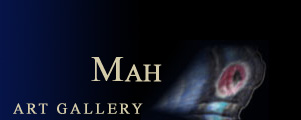|
|
| |
|
|
| |
|
| |
Biography
Bahram Dabiri was born in Shiraz in 1950. His family appreciated art; his mother was the daughter of a landowner who loved art and literature, and his father, who took no pride in aristocracy, had a deep interest in literature and history. Dabiri’s childhood was simultaneous with the disintegration of Iran's social system and the emergence of a new elite. Even the remnants of an aristocracy on the verge of extinction could not help keep his family in his hometown, leaving them with no alternative but to migrate to Tehran.
The twelve-year-old Dabiri adopted a strong interest in painting when he saw the movie The World of Suzie Wang, a dramatic story of an artist’s life. Later on he concluded that painting is well beyond an occupation; it is a way of life. Upon entering the College of Fine Arts, University of Tehran, in 1969, he studied the processes of modernism and the works of great artists while learning about his cultural identity and the national and historical background of his country. The works of Dabiri are classified into three distinct eras: first, his studying years; second, his big murals and paintings during the Revolution; and third, his works after 1981, which reflect various different dimensions of modernistic painting.
Dabiri is engaged with both modernism and tradition. His works are narratives that, at times, mix his fundamental beliefs with the language of life and contemporary painting to express the concepts within his mind. He has his own narrative and symbolic style, method and criteria and depicts the world sometimes delicately and poetically and at other times violently and horrifically. Nevertheless, he does not paint with the obsolete beliefs of his predecessors. In both cases, he creates a beautiful scene. Dabiri uses certain techniques that he has acquired through his experiences. For instance, he sometimes paints one scene within another, thus demonstrating an event that is taking place inside another.
What is significant in Dabiri’s paintings is his consistency of thought. Each of his works inevitably belongs to his mental world, and he paints with the same language and images that have been constructing his dreams for a very long time. He does not wish to create a world and space in a traditional, systematic easily decodable way. Rather, he tends to develop an atmosphere of infinity in which explicitness is inefficient; consequently, his works enjoy a deeper visual effect. His paintings are often based on epics or tragedies. The tragic essence may not be implied on the canvas directly, but may unveil itself within the dramatic circumstances of the figures in the painting. The forms and conditions encompassing their surroundings exhibit the force of destiny and tell of the pains and sufferings of humankind.
One of the important features of his works, which are combinations of drawing and painting, is that they both reassure the spectator of their being representations of real objects while mystifying him or her as to their actual meaning. There is no doubt over what has been painted; the hesitation arises about the time and place and purpose of the painting, and why the endlessness of space intentionally is broken where it is. At times it seems that certain images have been maintained in a vast but scattered space in which the pulse of life continues beating, and the sound of its breath is clearly audible.
|
| |
|
| |
Solo Exhibition
1968, Tehran, Sepeed Gallery
1975, Tehran, Goethe Gallery
1975, Tehran, Sayhoon Gallery
1977, Tehran, Tehran Gallery
1980, Tehran, Exhibition of Murals
1984, Tehran, Still Life, Personal Workshop
1984, Tehran, Designs and Sights, Personal Workshop
1985, Tehran, Curtains, Personal Workshop
1986, Tehran, Figures, Personal Workshop
1987, Tehran, Ferdowsi’ Mythology, Personal Workshop
1989, Tehran, Naghshenoghreh Gallery
1989, Tehran, Paffar Gallery
1989, Tehran, Personal Workshop
1991, Tehran, Birds and View, Darakeh
1991, Tehran, Golestan Gallery
1992, Tehran, Personal Workshop
1993, Tehran, Arya Gallery
1994, Tehran, Sayhoon Gallery
1995, Tehran, Nammad Exhibition, Golestan Gallery
1996, Tehran, 2nd Generation of Nammad Exhibition, Golestan Gallery
1996, Tehran, Calligraphy and Drawing, Personal Workshop
1996, Tehran, Ceramics and Metals, Golestan Gallery
1997, Tehran, Works of the Shiraz School, Personal Workshop
1998, Tehran, The Hens and Roosters of Bahram Dabiri, Golestan Gallery
1998, Tehran, Stained Glass Exhibition, Passargad Gallery
|
| |
|
| |
Group Exhibition
1976, Tehran, Naghsh Gallery
1976, Tehran, Derisee Gallery
1979, Tehran, Museum of Contemporary Art
1979, Tehran, Live Painting before the Public, Bagh Ferdose
1980, Tehran, Museum of Contemporary Art
1980, Tehran, The Council of Iranian Writers and Artists Exhibition
1980, Iran, Mobile Exhibitions in the Northern cities of Iran
1981, Tehran, Museum of Contemporary Art
1981, Tehran, The Council of Iranian Writers and Artists Exhibition
1982, Tehran, Museum of Contemporary Art
1992, Tehran, Exhibition for the women and children of Bosnia and Herzegovina
1992, Babbol, Iran, Abbi Gallery
1996, Tehran, French Embassy
|
| |
|
|



